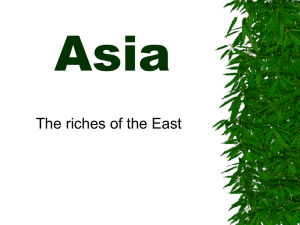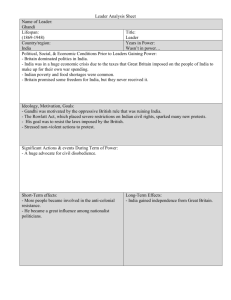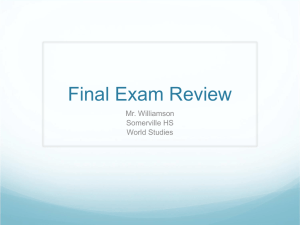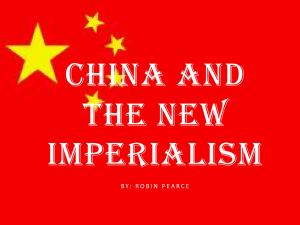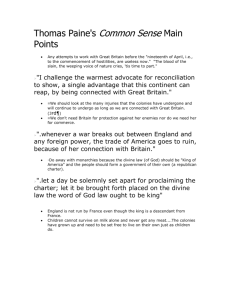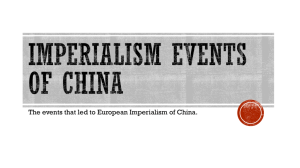BCC His 10 Topic Five The New Imperialism with Spanish American
advertisement
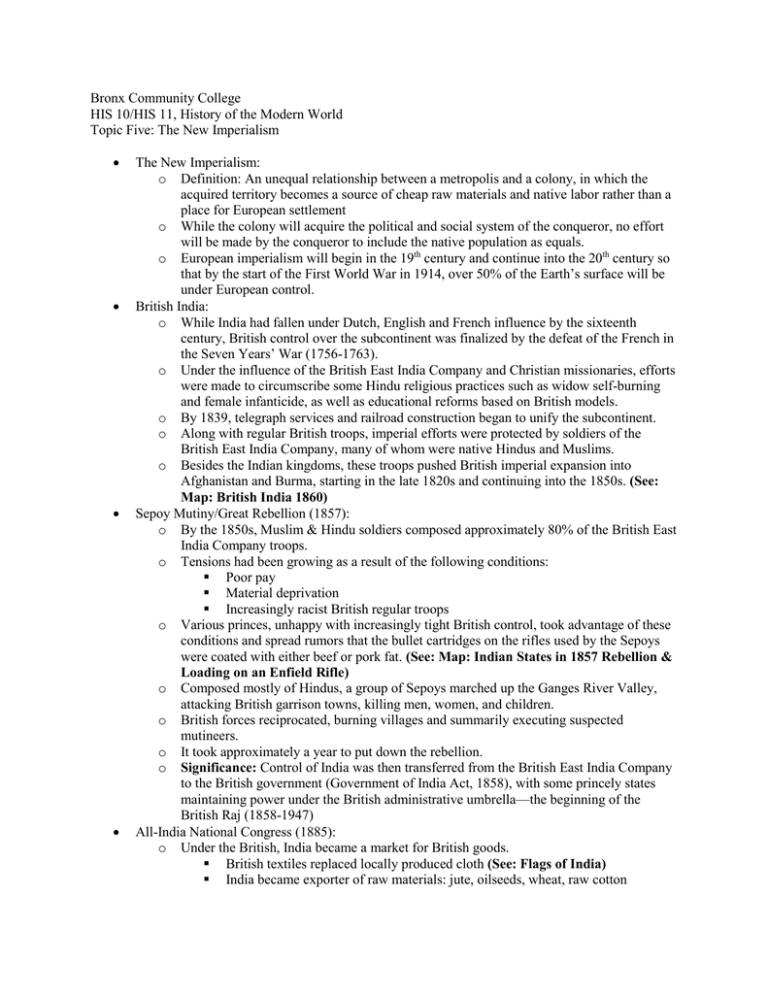
Bronx Community College HIS 10/HIS 11, History of the Modern World Topic Five: The New Imperialism The New Imperialism: o Definition: An unequal relationship between a metropolis and a colony, in which the acquired territory becomes a source of cheap raw materials and native labor rather than a place for European settlement o While the colony will acquire the political and social system of the conqueror, no effort will be made by the conqueror to include the native population as equals. o European imperialism will begin in the 19th century and continue into the 20th century so that by the start of the First World War in 1914, over 50% of the Earth’s surface will be under European control. British India: o While India had fallen under Dutch, English and French influence by the sixteenth century, British control over the subcontinent was finalized by the defeat of the French in the Seven Years’ War (1756-1763). o Under the influence of the British East India Company and Christian missionaries, efforts were made to circumscribe some Hindu religious practices such as widow self-burning and female infanticide, as well as educational reforms based on British models. o By 1839, telegraph services and railroad construction began to unify the subcontinent. o Along with regular British troops, imperial efforts were protected by soldiers of the British East India Company, many of whom were native Hindus and Muslims. o Besides the Indian kingdoms, these troops pushed British imperial expansion into Afghanistan and Burma, starting in the late 1820s and continuing into the 1850s. (See: Map: British India 1860) Sepoy Mutiny/Great Rebellion (1857): o By the 1850s, Muslim & Hindu soldiers composed approximately 80% of the British East India Company troops. o Tensions had been growing as a result of the following conditions: Poor pay Material deprivation Increasingly racist British regular troops o Various princes, unhappy with increasingly tight British control, took advantage of these conditions and spread rumors that the bullet cartridges on the rifles used by the Sepoys were coated with either beef or pork fat. (See: Map: Indian States in 1857 Rebellion & Loading on an Enfield Rifle) o Composed mostly of Hindus, a group of Sepoys marched up the Ganges River Valley, attacking British garrison towns, killing men, women, and children. o British forces reciprocated, burning villages and summarily executing suspected mutineers. o It took approximately a year to put down the rebellion. o Significance: Control of India was then transferred from the British East India Company to the British government (Government of India Act, 1858), with some princely states maintaining power under the British administrative umbrella—the beginning of the British Raj (1858-1947) All-India National Congress (1885): o Under the British, India became a market for British goods. British textiles replaced locally produced cloth (See: Flags of India) India became exporter of raw materials: jute, oilseeds, wheat, raw cotton o During the Raj, the British expanded the transportation and communication infrastructures of the subcontinent, improved medical treatment, and improved and Anglicized the educational system. o Recognizing the need for and benefits of a local bureaucracy, the British opened the educational system, especially the university system, to members of the Hindu and Muslim elites. o Under the influence of Ram Moan Roy (1772-1833), a generation of university-trained Hindus combined ideas from India and the West. o In 1884, the British government in India approved the creation of an Indian National Congress. While Indians were allowed to voice their concern, they had no power over British colonial policies. o Established in 1885, the All-India National Congress included professional-class Muslims and Hindus, with Pro-British Hindus usually holding control. o In 1906, with Hindus continuing to control the All-India National Congress, members of the Muslim elite established the All-India Muslim League. China, Trade & Opium: o Early 19th century: Great Britain conducted an extensive trade with China, especially in Indian cotton. With increased demand for cotton in Great Britain, though, the British needed a substitute good to trade. They found it in opium. o Opium was legal in Great Britain and seen as a moderate relaxant in China. o By 1832, Chinese demand for opium led to an outflow of silver—the first time in Chinese commercial history. o 1836: Chinese authorities banned opium, closing smoking parlors and executing opium dealers. o June 1839: agents of the Chinese government destroyed over 2 million pounds of British opium, leading Great Britain to prepare for war. o First Opium War (1839 to 1842): British and French naval ships attacked Chinese port cities o August 1842: Treaty of Nanking: China paid Great Britain $12 million indemnity for the destroyed opium. China opened five port cities to British traders. British consul was to be stationed in each city to protect British interests. Hong Kong was ceded to Great Britain. China was forced to expand its trade with Great Britain in tea, porcelain, wallpapers, lacquer ware, and silk. o By 1844: similar trade relations were forced upon China by France and the United States. o July 1844: a treaty between China and the United States provided American citizens in China with extraterritoriality. o Even with the treaty, the British claimed that China was inhibiting their trade. o 1856 to 1860 Second Opium War (Great Britain & France vs. China): Opening of additional treaty ports Guaranteed safety of Christian missionaries Extraterritoriality for British throughout China Legalization of opium trade 1860: British capturing the Chinese capital, Peking (now Beijing) o In the decades that followed, China was racked by internal uprisings, the loss of control of parts of what are now Viet Nam, lost the Sino-Japanese War (1895), conceded control over Korea, and was forced to make additional concessions to western powers and Christian missionaries. o The Chinese population suffered under famine and an increasing tax burden. The Boxer Rebellion, 1898-1899: o Empress Dowager Cixi, a weak regent ruling until the heir to the throne came of age, encouraged a religious society, the Righteous and Harmonious Fists (the Boxers) to attack western settlements. o Originally both anti-Christian and anti-government, the Boxers signed a pact with the government in 1898. o During the Rebellion itself, hundreds and westerners, mostly missionaries, were attacked and killed. o June 1900: the Boxers attacked the foreign quarter of the city of Beijing, killing members of the German and Japanese legation. o Combined forces from the United States, Great Britain, France, Italy, Japan, and Russia finally put down the rebellion. o Results of the Boxer Rebellion: China was again required to pay indemnities to western powers Western powers permanently stationed troops in Beijing Russia seized control of Manchuria Suez Canal (1869): o French and British competed for control of territories in Asia, but were confronted with the long voyage around Africa. o Both countries sought to build a direct route, building a canal across the Suez Peninsula. o While Egypt was technically under the control of the Ottoman Empire, Egyptian rulers in the mid-1800s desired an independent policy of modernization: development of commercial agriculture European settlements borrowing heavily from French and British bankers to fund these projects. o Being unable to pay off Egypt’s debt to France, Sa’id, the Pasha of Egypt, gave France a contract to build a canal. o Built by French engineer, Ferdinand de Lesseps (1805-1894), the Suez Canal opened in 1869. o The control of the resulting Suez Canal Company was divided between Sa’id (51%) and French investors (49%). o Sa’id’s son and successor Isma’il used the money from the stock to continue to modernize Egypt: first school for girls national library large-scale irrigation projects o Isma’il overspent and almost bankrupted the government o 1875: to cover the expenses, Isma’il sold his shares to the British o While his actions infuriated the French, Isma’il was still not able to pay off the debt. o 1876: France and Great Britain combined and forced Egypt to surrender its finances to their financial commissioners. o As a result, national resentment grew in Egypt, led by the Egyptian National Party (1879), marking the beginning of Egyptian nationalism. Scramble for Africa & Congress of Berlin (1884): o With the end of the slave trade came an effort to “civilize” African nations (conversion to Christianity). o This movement, however, required the plotting of the interior of the continent. o Both missionaries and scientists engaged in expeditions into the interior. o With nationalism and industrialization on the rise in Europe, the western powers began searching for cheap sources of raw materials and labor o Catalyst: King Leopold II of Belgium hired Henry Morton Stanley to explore and claim central Africa. o Stanley established a number of stations along the Congo River—the beginning of the Congo Free State, which Leopold proclaimed in 1879. o Fearful of Belgian inroads, France and Portugal made claims to territory ate the mouth of the Congo River. o Additional claims: Germany laid claim to three strips of land in East Africa Great Britain turned south from the Suez canal o Otto von Bismarck, concerned over destabilizing the existing peace in Europe, called the European powers together in Berlin from November 1884 to February 1885 to come up with a plan to rationally divide up the spoils of Africa: Belgium got the Congo Free State Great Britain received territory in Niger Germany gained control over Tanganyika Future claims to be based on “effective occupation”: the power that controlled the coast had first claim on the adjacent interior. Any new claim to coastal territory had to be approved by the other signatures of the Berlin Agreement. Final outcome: Germany: Southwest Africa, Rwanda & Burundi Great Britain: Kenya, Uganda, Nigeria & Zanzibar Portugal: Angola & Mozambique Spain territory south of Morocco Italy: Libya & Somalia Spanish-American War & the Roosevelt Corollary: o By 1898, Spain’s once grand empire was reduced to Puerto Rico (semi-autonomous), Cuba, and the Philippines. o Cuba: From 1825 to 1895, Spanish control of Cuba had been challenged by a number of slave rebellions and uprisings by the Creole planter population. During this same period American investors became increasingly interest in Cuban sugar plantations. In 1898, in an effort to influence another uprising and protect American investments on the Island, the United States sent the battleship, U.S.S. Maine to Havana Harbor. Promoted by American investors and the yellow press, the United States declared war in 1898 and defeated the Spanish within eight weeks. The war was promoted as an effort to protect the “white” Cubans from the darkskinned Spanish dictators. As a result of the Platt Amendment, Cuba, while technically autonomous, has to have its domestic and foreign-policy decisions approved by the United States and provide land for an American naval base—Guantanamo Bay. o Philippines: As tension in Cuba grew, the United States government sent a fleet, led by Commodore George Dewey to the Philippines to attack the Spanish fleet in Manila Harbor. The battle was a route and the Spanish surrendered. The Americans were sent, in part, to aid the Filipinos in gaining their independence. Following the defeat of the Spanish, the United States refused to grant the Philippines independence and took control of the islands as a true colony. A seven-years guerilla war resulted that cost more in money and lives than the fighting of the Spanish-American War. Historians have compared the fighting to that in Viet Nam. Roosevelt Corollary to the Monroe Doctrine: o 1904: Building on James Monroe’s idea that the European powers should stay out of the affairs of the countries of the western hemisphere, President Roosevelt announced the Roosevelt Corollary: “the United States had a right to intervene in those Latin American states to deal with cases of ‘chronic wrongdoing.’” o Using the Roosevelt Corollary as a justification, the United States will intervene in the domestic affairs and occupy the territory of a number of Latin American states. (See Map of American Intervention.)

